英文写作名词解释
narrative essay名词解释
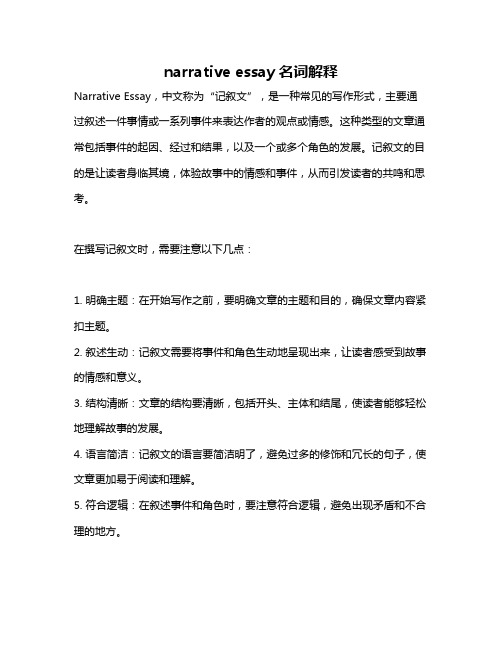
narrative essay名词解释
Narrative Essay,中文称为“记叙文”,是一种常见的写作形式,主要通过叙述一件事情或一系列事件来表达作者的观点或情感。
这种类型的文章通常包括事件的起因、经过和结果,以及一个或多个角色的发展。
记叙文的目的是让读者身临其境,体验故事中的情感和事件,从而引发读者的共鸣和思考。
在撰写记叙文时,需要注意以下几点:
1. 明确主题:在开始写作之前,要明确文章的主题和目的,确保文章内容紧扣主题。
2. 叙述生动:记叙文需要将事件和角色生动地呈现出来,让读者感受到故事的情感和意义。
3. 结构清晰:文章的结构要清晰,包括开头、主体和结尾,使读者能够轻松地理解故事的发展。
4. 语言简洁:记叙文的语言要简洁明了,避免过多的修饰和冗长的句子,使文章更加易于阅读和理解。
5. 符合逻辑:在叙述事件和角色时,要注意符合逻辑,避免出现矛盾和不合理的地方。
总之,记叙文是一种富有情感和情节的写作形式,能够引起读者的共鸣和思考,对于培养语言能力和表达能力有很大的帮助。
英美文学名词解释整理版
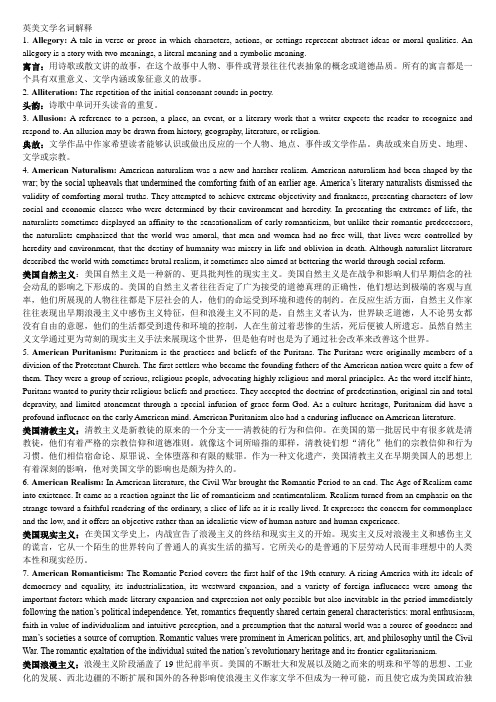
英美文学名词解释1. Allegory: A tale in verse or prose in which characters, actions, or settings represent abstract ideas or moral qualities. An allegory is a story with two meanings, a literal meaning and a symbolic meaning.寓言:用诗歌或散文讲的故事,在这个故事中人物、事件或背景往往代表抽象的概念或道德品质。
所有的寓言都是一个具有双重意义、文学内涵或象征意义的故事。
2.Alliteration: The repetition of the initial consonant sounds in poetry.头韵:诗歌中单词开头读音的重复。
3.Allusion:A reference to a person, a place, an event, or a literary work that a writer expects the reader to recognize and respond to. An allusion may be drawn from history, geography, literature, or religion.典故:文学作品中作家希望读者能够认识或做出反应的一个人物、地点、事件或文学作品。
典故或来自历史、地理、文学或宗教。
4. American Naturalism: American naturalism was a new and harsher realism. American naturalism had been shaped by the war; by the social upheavals that undermined the comforting faith of an earlier age. America’s literary naturalists dismissed the validity of comforting moral truths. They attempted to achieve extreme objectivity and frankness, presenting characters of low social and economic classes who were determined by their environment and heredity. In presenting the extremes of life, the naturalists sometimes displayed an affinity to the sensationalism of early romanticism, but unlike their romantic predecessors, the naturalists emphasized that the world was amoral, that men and women had no free will, that lives were controlled by heredity and environment, that the destiny of humanity was misery in life and oblivion in death. Although naturalist literature described the world with sometimes brutal realism, it sometimes also aimed at bettering the world through social reform.美国自然主义:美国自然主义是一种新的、更具批判性的现实主义。
用于名词解释的英文
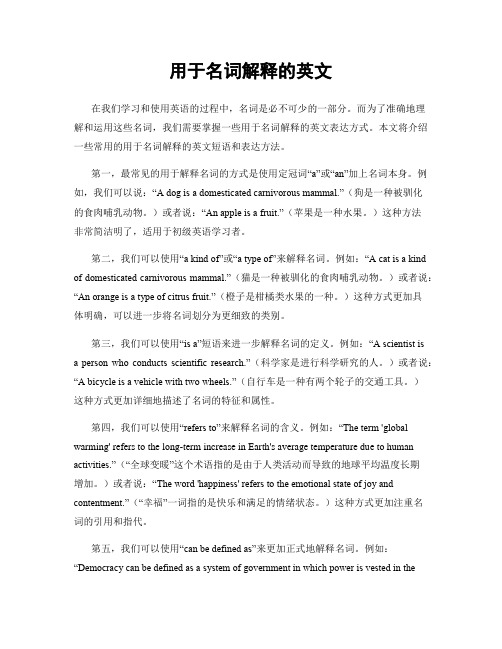
用于名词解释的英文在我们学习和使用英语的过程中,名词是必不可少的一部分。
而为了准确地理解和运用这些名词,我们需要掌握一些用于名词解释的英文表达方式。
本文将介绍一些常用的用于名词解释的英文短语和表达方法。
第一,最常见的用于解释名词的方式是使用定冠词“a”或“an”加上名词本身。
例如,我们可以说:“A dog is a domesticated carnivorous mammal.”(狗是一种被驯化的食肉哺乳动物。
)或者说:“An apple is a fruit.”(苹果是一种水果。
)这种方法非常简洁明了,适用于初级英语学习者。
第二,我们可以使用“a kind of”或“a type of”来解释名词。
例如:“A cat is a kind of domesticated carnivorous mammal.”(猫是一种被驯化的食肉哺乳动物。
)或者说:“An orange is a type of citrus fruit.”(橙子是柑橘类水果的一种。
)这种方式更加具体明确,可以进一步将名词划分为更细致的类别。
第三,我们可以使用“is a”短语来进一步解释名词的定义。
例如:“A scientist isa person who conducts scientific research.”(科学家是进行科学研究的人。
)或者说:“A bicycle is a vehicle with two wheels.”(自行车是一种有两个轮子的交通工具。
)这种方式更加详细地描述了名词的特征和属性。
第四,我们可以使用“refers to”来解释名词的含义。
例如:“The term 'global warming' refers to the long-term increase in Earth's average temperature due to human activities.”(“全球变暖”这个术语指的是由于人类活动而导致的地球平均温度长期增加。
(完整版)英美文学名词解释最全版
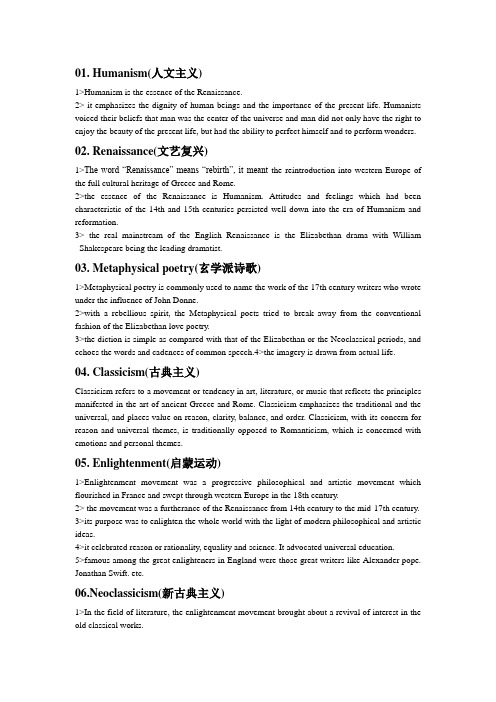
01. Humanism(人文主义)1>Humanism is the essence of the Renaissance.2> it emphasizes the dignity of human beings and the importance of the present life. Humanists voiced their beliefs that man was the center of the universe and man did not only have the right to enjoy the beauty of the present life, but had the ability to perfect himself and to perform wonders.02. Renaissance(文艺复兴)1>The word “Renaissance”means “rebirth”, it meant the reintroduction into western Europe of the full cultural heritage of Greece and Rome.2>the essence of the Renaissance is Humanism. Attitudes and feelings which had been characteristic of the 14th and 15th centuries persisted well down into the era of Humanism and reformation.3> the real mainstream of the English Renaissance is the Elizabethan drama with William Shakespeare being the leading dramatist.03. Metaphysical poetry(玄学派诗歌)1>Metaphysical poetry is commonly used to name the work of the 17th century writers who wrote under the influence of John Donne.2>with a rebellious spirit, the Metaphysical poets tried to break away from the conventional fashion of the Elizabethan love poetry.3>the diction is simple as compared with that of the Elizabethan or the Neoclassical periods, and echoes the words and cadences of common speech.4>the imagery is drawn from actual life.04. Classicism(古典主义)Classicism refers to a movement or tendency in art, literature, or music that reflects the principles manifested in the art of ancient Greece and Rome. Classicism emphasizes the traditional and the universal, and places value on reason, clarity, balance, and order. Classicism, with its concern for reason and universal themes, is traditionally opposed to Romanticism, which is concerned with emotions and personal themes.05. Enlightenment(启蒙运动)1>Enlightenment movement was a progressive philosophical and artistic movement which flourished in France and swept through western Europe in the 18th century.2> the movement was a furtherance of the Renaissance from 14th century to the mid-17th century.3>its purpose was to enlighten the whole world with the light of modern philosophical and artistic ideas.4>it celebrated reason or rationality, equality and science. It advocated universal education.5>famous among the great enlighteners in England were those great writers like Alexander pope. Jonathan Swift. etc.06.Neoclassicism(新古典主义)1>In the field of literature, the enlightenment movement brought about a revival of interest in the old classical works.2>this tendency is known as neoclassicism. The Neoclassicists held that forms of literature were to be modeled after the classical works of the ancient Greek and Roman writers such as Homer and Virgil and those of the contemporary French ones.3> they believed that the artistic ideals should be order, logic, restrained emotion and accuracy, and that literature should be judged in terms of its service to humanity.07. The Graveyard School(墓地派诗歌)1>The Graveyard School refers to a school of poets of the 18th century whose poems are mostly devoted to a sentimental lamentation or meditation on life. Past and present ,with death and graveyard as themes.2>Thomas Gray is considered to be the leading figure of this school and his Elegy written in a country churchyard is its most representative work.08. Romanticism(浪漫主义)1>In the mid-18th century, a new literary movement called romanticism came to Europe and then to England.2>It was characterized by a strong protest against the bondage of neoclassicism, which emphasized reason, order and elegant wit. Instead, romanticism gave primary concern to passion, emotion, and natural beauty.3>In the history of literature. Romanticism is generally regarded as the thought that designates a literary and philosophical theory which tends to see the individual as the very center of all life and experience. 4> The English romantic period is an age of poetry which prevailed in England from 1798 to 1837. The major romantic poets include Wordsworth, Byron and Shelley.09. Byronic Hero(拜伦式英雄)1>Byronic hero refers to a proud, mysterious rebel figure of noble origin.2> with immense superiority in his passions and powers, this Byronic Hero would carry on his shoulders the burden of righting all the wrongs in a corrupt society. And would rise single-handedly against any kind of tyrannical rules either in government, in religion, or in moral principles with unconquerable wills and inexhaustible energies.3> Byron’s chief contribution to English literature is his creation of the “Byronic Hero”10. Critical Realism(批判现实主义)1>Critical Realism is a term applied to the realistic fiction in the late 19th and early 20th centuries.2> It means the tendency of writers and intellectuals in the period between 1875 and 1920 to apply the methods of realistic fiction to the criticism of society and the examination of social issues.3> Realist writers were all concerned about the fate of the common people and described what was faithful to reality.4> Charles Dickens is the most important critical realist.11. Aestheticism(美学主义)1>The basic theory of the Aesthetic movement--- “art for art’s sake” was set forth by a French poet, Theophile Gautier, the first Englishman who wrote about the theory of aestheticism was Walter Pater.2> aestheticism places art above life, and holds that life should imitate art, not art imitate life.3> According to the aesthetes, all artistic creation is absolutely subjective as opposed to objective. Art should be free from any influence of egoism. Only when art is for art’s sake, can it be immortal. They believed that art should be unconcerned with controversial issues, such as politics and morality, and that it should be restricted to contributing beauty in a highly polished style.4> This is one of the reactions against the materialism and commercialism of the Victorian industrial era, as well as a reaction against the Victorian convention of art for morality’s sake, or art for money’s sake.美学运动的基本原则”为艺术而艺术”最初由法国诗人西奥费尔.高缔尔提出,英国运用该美学理论的第一人是沃尔特.佩特.美学主义崇尚艺术高于生活,认为生活应模仿艺术,而不是艺术模仿生活.在美学主义看来,所有的艺术创作都是绝对主观而非客观的产物.艺术不应受任何功利的影响,只有当艺术为艺术而创作时,艺术才能成为不朽之作.他们还认为艺术不应只关注一些热点话题如政治和道德问题,艺术应着力于以华丽的风格张扬美.这是对维多利亚工业发展时期物质崇拜的一种回应,也是向艺术为道德或为金钱而服务的维多利亚传统的挑战.12.The Victorian period(维多利亚时期)1>In this period, the novel became the most widely read and the most vital and challenging expression of progressive thought. While sticking to the principle of faithful representation of the 18th century realist novel, novelists in this period carried their duty forward to criticism of the society and the defense of the mass.2> although writing from different points of view and with different techniques, they shared one thing in common, that is, they were all concerned about the fate of the common people. They were angry with the inhuman social institutions, the decaying social morality as represented by the money-worship and Utilitarianism, and the widespread misery, poverty and injustice.3>their truthful picture of people’s life and bitter and strong criticism of the society had done much in awakening the public consciousness to the social problems and in the actual improvement of the society.4> Charles Dickens is the leading figure of the Victorian period.13. Modernism(现代主义)1>Modernism is comprehensive but vague term for a movement , which begin in the late 19th century and which has had a wide influence internationally during much of the 20th century.2> modernism takes the irrational philosophy and the theory of psycho-analysis as its theoretical case.3> the term pertains to all the creative arts. Especially poetry, fiction, drama, painting, music and architecture.4> in England from early in the 20th century and during the 1920s and 1930s, in America from shortly before the first world war and on during the inter-war period, modernist tendencies were at their most active and fruitful.5>as far as literature is concerned, Modernism reveals a breaking away from established rules, traditions and conventions. fresh ways of looki ng at man’s position and function in the universe and many experiments in form and style. It is particularly concerned with language and how to use it and with writing itself.14. Stream of consciousness(意识流)(or interior monologue)In literary criticism, Stream of consciousness denotes a literary technique which seeks to describe an individual’s point of view by giving the written equivalent of the character’s thought processes. Stream of consciousness writing is strongly associated with the modernist movement. Its introduction in the literary context, transferred from psychology, is attributed to May Sinclair. Stream of consciousness writing is usually regarded as a special form of interior monologue and is characterized by associative leaps in syntax and punctuation that can make the prose difficult to follow, tracing as they do a character’s fragmentary thoughts and sensory feelings. Famous writers to employ this technique in the English language include James Joyce and William Faulkner.学术界认为意识流是一种通过直接描述人物思维过程来寻求个人视角的文学写作技巧。
写作基础的名词解释
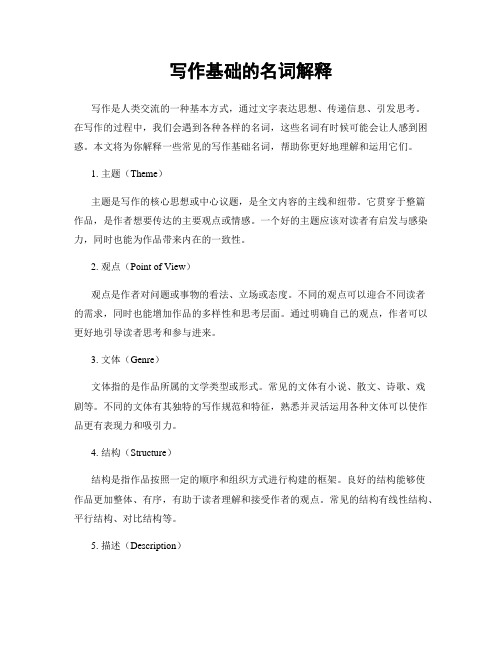
写作基础的名词解释写作是人类交流的一种基本方式,通过文字表达思想、传递信息、引发思考。
在写作的过程中,我们会遇到各种各样的名词,这些名词有时候可能会让人感到困惑。
本文将为你解释一些常见的写作基础名词,帮助你更好地理解和运用它们。
1. 主题(Theme)主题是写作的核心思想或中心议题,是全文内容的主线和纽带。
它贯穿于整篇作品,是作者想要传达的主要观点或情感。
一个好的主题应该对读者有启发与感染力,同时也能为作品带来内在的一致性。
2. 观点(Point of View)观点是作者对问题或事物的看法、立场或态度。
不同的观点可以迎合不同读者的需求,同时也能增加作品的多样性和思考层面。
通过明确自己的观点,作者可以更好地引导读者思考和参与进来。
3. 文体(Genre)文体指的是作品所属的文学类型或形式。
常见的文体有小说、散文、诗歌、戏剧等。
不同的文体有其独特的写作规范和特征,熟悉并灵活运用各种文体可以使作品更有表现力和吸引力。
4. 结构(Structure)结构是指作品按照一定的顺序和组织方式进行构建的框架。
良好的结构能够使作品更加整体、有序,有助于读者理解和接受作者的观点。
常见的结构有线性结构、平行结构、对比结构等。
5. 描述(Description)描述是通过文字描绘事物的外表、细节、特征等,以便读者能够形象地感知、理解和体验。
描述能够增强作品的真实感和可视化能力,使读者更容易产生共鸣。
6. 对比(Comparison)对比是通过比较事物的相似性和差异性来凸显观点的一种修辞手法。
通过对比,作者能够更清晰地表达自己的观点,使读者更好地理解和思考。
7. 修辞(Rhetoric)修辞是指运用一种特定的语言风格和技巧来表达观点、加强语言的说服力和表现力。
常见的修辞手法包括比喻、夸张、反问、排比等,它们能够使作品更生动、有趣,增加读者的阅读体验。
8. 内容(Content)内容是指作品中所呈现的具体信息、思想、情感等。
英文写作名词解释
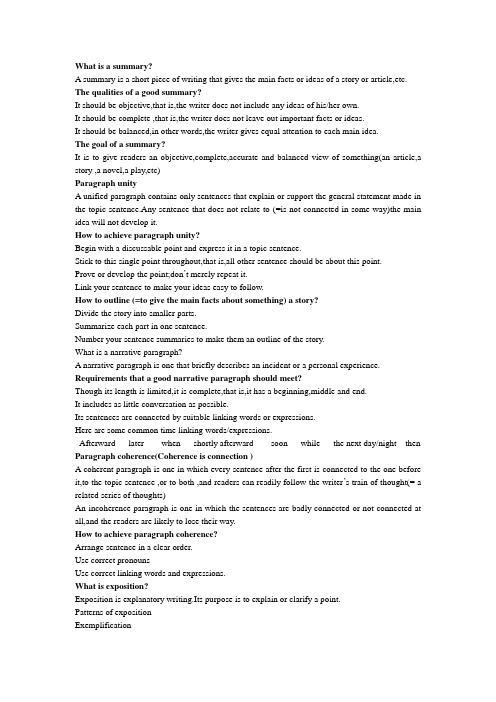
What is a summary?A summary is a short piece of writing that gives the main facts or ideas of a story or article,etc. The qualities of a good summary?It should be objective,that is,the writer does not include any ideas of his/her own.It should be complete ,that is,the writer does not leave out important facts or ideas.It should be balanced,in other words,the writer gives equal attention to each main idea.The goal of a summary?It is to give readers an objective,complete,accurate and balanced view of something(an article,a story ,a novel,a play,etc)Paragraph unityA unified paragraph contains only sentences that explain or support the general statement made in the topic sentence.Any sentence that does not relate to (=is not connected in some way)the main idea will not develop it.How to achieve paragraph unity?Begin with a discussable point and express it in a topic sentence.Stick to this single point throughout,that is,all other sentence should be about this point.Prove or develop the point;don’t merely repeat it.Link your sentence to make your ideas easy to follow.How to outline (=to give the main facts about something) a story?Divide the story into smaller parts.Summarize each part in one sentence.Number your sentence summaries to make them an outline of the story.What is a narrative paragraph?A narrative paragraph is one that briefly describes an incident or a personal experience. Requirements that a good narrative paragraph should meet?Though its length is limited,it is complete,that is,it has a beginning,middle and end.It includes as little conversation as possible.Its sentences are connected by suitable linking words or expressions.Here are some common time linking words/expressions.Afterward later when shortly afterward soon while the next day/night then Paragraph coherence(Coherence is connection )A coherent paragraph is one in which every sentence after the first is connected to the one before it,to the topic sentence ,or to both ,and readers can readily follow the writer’s train of thought(= a related series of thoughts)An incoherence paragraph is one in which the sentences are badly connected or not connected at all,and the readers are likely to lose their way.How to achieve paragraph coherence?Arrange sentence in a clear order.Use correct pronounsUse correct linking words and expressions.What is exposition?Exposition is explanatory writing.Its purpose is to explain or clarify a point.Patterns of expositionExemplificationProcess analysisCause-Effect analysisComparison and contrastClassificationDefinitionAnalogyWhat is exemplification?Exemplification is a method of supporting a thesis statement with a series of specific examples or sometimes,with a single extended example.It is one of the most common and most useful means of developing a paragraph or an essay.What is an essay?An essay is a related group of paragraphs written for some purpose.Types of essaysEssays can be classified into types,or modes,according to their purposes.Narrative essays relate a sequence of events,whether factual or not.Descriptive essays create a word picture of a scene,a person,or an object.Expositive essays explain--to inform,instruct,clarify,illustrate,or define.Argumentative essays state an opinion and defend it logically.Basic structure of an expositive essayAn expositive essay has three parts:A beginning called the introduction.A middle called the body.An end called the conclusion.Elements of the expositive essayOutliningThesis statementTitleTransitionWhat is an outline?An outline is a method of organizing materials in logical order.It is a list that shows the main ideas and the structure of something you are planning to write.In other words,it is a plan for a piece of writing.Constructing an outline makes the writing of your essay easier.Types of outline1.Topic outline,which uses only key words and phrases.2.Sentence outline,which uses complete sentence.Format(the arrangement ,design,or organization of something)A topic outline looks like this:Thesis:In my first year at college,I learned to spend my money wisely.What is process analysis?A process analysis is a step-by-step explanation of how to do something,or how something works/done or made,or something happened.What is process analysis used for?1.To give directions to people who want or need to perform the process.(giving instructions )2.To give information to those who want to understand the process but may not actually performit.(giving information)3.To explain how something happened.(giving the history)What are the major types of process analysis?1.Directive process analysis which is aimed at explaining how to do or make something.rmative process analysis which is aimed at explaining how something is done/works or how something took place/happened.What is comparison/contrast?Comparison/contrast is a method of developing a paragraph or an parison shows similarity while contrast shows difference.The word comparison is sometimes used to mean both comparison and contrast.What is comparison/contrast used for?1.To clarify something unknown or not well understood.2.To lead a new way of viewing something familiar.3.To bring one or both of the subjects into sharper focus.4.To show that one subject is better than the other.What is classification?Classification is the method of grouping objects,people,or ideas systematically.It is one of the most useful organizational strategies in writing.What is classification used for?1.To organize and perceive the world around us.2.To present a mass of material by means of some orderly system.3.To deal with complex or abstract topics by breaking a broad subject into smaller,neatly sorted categories.What is definition?1.Definition is the explanation of the meaning of a word or concept.2.Definition is also a method of developing an essay.What is analogy?Analogy is an extended comparison based on the similar features of two things of different classes,one familiar one easily understood,the other unfamiliar ,abstract,or complicated.It is an important method of exposition.What are transition?Transition,also called”transitional devices”,are words,phrases,and even whole sentences that link sentence to one another.What is a journal?A journal is a record of experiences,ideas,or reflections kept regularly for private use.It is something “for you eye only ”.So you can write from your heart and let ideas and feelings flow freely.Journal writing is a form of free-writing,which involves writing whatever comes to your mind about what happens around you and what you observe and think about.Argumentation and persuasion defined.Argumentation-persuasion is the type of writing in which writers try to encourage readers to accept their point of view on a controversial issue.In argumentation ,writers use objectives,logical reasoning,facts,and hard evidence to demonstrate the soundness of a position.Their purpose is to encourage readers to accept their point of view.In persuasion,writers use emotional language and dramatic appeals to readers' concerns,beliefs and values,often in the hope of encouraging then to take a specific action,besides,encouraging acceptance of an opinion.Argumentation and persuasion are frequently used together in an essay.Also,the two terms are often used interchangeably.The claim definedClaims,or propositions,represent answers to what you are trying to prove in an argumentative essay.Although they are the conclusions of your arguments,they often appear as these statements. Abstract&concrete wordsConcrete words identify persons and things that can be perceived by the senses--seen,heard,tasted,felt,smelled,e.g.table,boy,rose,etc.Abstract words denote qualities,concepts,relationships,acts,conditions,ideas that we can’t perceive directly through our five senses,e.g.honesty,friendship,life,etc.Most words are neither wholly abstract nor concrete.They are between the two extremes,e.g.exercise,rest,answer,etc.General&specific wordsSpecific words identify individual items in a group,e.g.BuickGeneral words relate to categories,an overall group,e.g.carMost words are neither wholly general nor specific.They are between the two extremes,e.g.child,student,flower,etc.The support definedThe ideas and information intended to convince readers that the claim is sound or believable. What is conciseness?Conciseness means being direct and to the point.Redundant words or wordy writing is not concise.Do not over-use words to deliver the message in your writing.Refutation definedRefutation is attempts to prove views against the writer’s position wrong or false.It is often an indispensable part of an argumentative essay,for it shows that the writer is aware of opposing viewpoints and has thought about both sides.Essays that mainly refute opposing views are known as rebuttal arguments.Fallacies definedFallacies are statements that may sound reasonable or true but are not logically defensible and may actually be deceptive.The emotional appeal definedEmotional appeal is a strategy writers and public speakers use to persuade,which is to arouse the reader’s/audience’s feelings to reinforce an argument.真题:What is the research paper?What is the process of writing it?A research paper is usually a formal,fairly long and well-documented composition.Process:1.choosing a topic2.Collecting information3.Analyzing the information,organizing ideas and working out an outline4.Writing the first draft5.Revising the draft and finalizing the paper.What is the sentence?What is the effective sentence?A sentence contains at least a subject and a predicate verb:if the verb is transitive,there must be an object,if the verb is a link verb,there must be a predicative or complement.They are unity,coherence,conciseness,emphasis and variety.How many types of sentences according to the use?What are they?There are four.They are declarative,interrogative,imperative and exclamatory sentence.How many types of sentences according to the structure?What are they?There are four.They are simple,compound,complex and compound-complex sentence.。
外国文学名词解释

外国文学名词解释
以下是一些常见的外国文学名词解释:
1. 小说(Novel):一种长篇故事性的文学形式,通常以虚构的情节和人物为基础。
2. 诗歌(Poetry):一种以韵律、节奏和表达深层意义为特点的文学形式。
3. 戏剧(Drama):一种以对话和行动为主要表现手段的文学形式,通常在舞台上演出。
4. 散文(Prose):一种不受特定韵律和节奏限制的文学形式,通常以故事、评论或描述为主。
5. 自传(Autobiography):一种以作者自己的生活经历为基础的文学作品。
6. 传记(Biography):一种以某个人的生平事迹为基础的文学作品。
7. 文学批评(Literary Criticism):对文学作品进行分析和评价的学术研究领域。
8. 现实主义(Realism):一种文学流派,强调对现实生活的客观描写和真实性。
9. 浪漫主义(Romanticism):一种文学流派,强调个人情感、幻想和想象力。
10. 象征主义(Symbolism):一种文学流派,强调使用象征和隐喻来传达深层意义。
英语四级作文专有名词
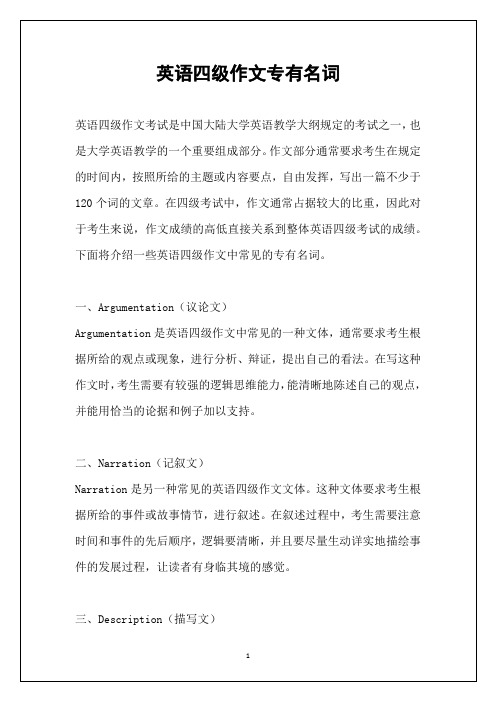
Argumentation是英语四级作文中常见的一种文体,通常要求考生根据所给的观点或现象,进行分析、辩证,提出自己的看法。在写这种作文时,考生需要有较强的逻辑思维能力,能清晰地陈述自己的观点,并能用恰当的论据和例子加以支持。
二、Narration(记叙文)
Narration是另一种常见的英语四级作文文体。这种文体要求考生根据所给的事件或故事情节,进行叙述。在叙述过程中,考生需要注意时间和事件的先后顺序,逻辑要清晰,并且要尽量生动详实地描绘事件的发展过程,让读者有身临其境的感觉。
五、Thesis statement(论文声明)
在英语四级作文中,论文声明是一个非常重要的概念。它要求考生在写作的最开始部分,对自己的立场或观点进行简要的表述。论文声明通常体现了考生在整篇文章中要表达的核心思想,因此要求考生在明确自己立场的同时,要简洁明了地表达出来。
六、Supporting evidence(论据)
在议论文中,论据是支持观点的重要依据。考生需要通过丰富的知识储备和逻辑思维,能够提供有力的论据来支持自己的观点,使文章更加有说服力。
七、Conclusion(结论)
在英语四级作文中,结论部分是整篇文章的收尾部分,也是表明作者观点的最终归宿。结论需要简洁明了地总结全文的核心内容,对全文进行概括,让读者对文章的主题有一个清晰的印象。
三、Description(描写文)
Description文体要求考生根据所给的人、物、地点等信息,进行描写。这种文体要求考生通过形象、生动的语言描绘出所给对象的形象和特征,让读者对所描写的对象有清晰而生动的印象。
四、Exposition(说明文)
Exposition文体要求考生对所给的问题或现象进行说明,通常需要考生能够分析问题或现象的原因、影响等内容,并能够用简练、明了的语言进行阐述。
大学英语语法考试名词解释
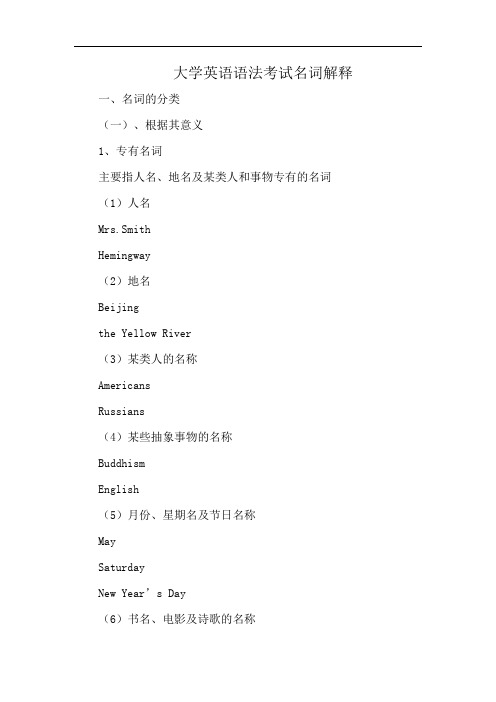
大学英语语法考试名词解释一、名词的分类(一)、根据其意义1、专有名词主要指人名、地名及某类人和事物专有的名词(1)人名Mrs.SmithHemingway(2)地名Beijingthe Yellow River(3)某类人的名称AmericansRussians(4)某些抽象事物的名称BuddhismEnglish(5)月份、星期名及节日名称MaySaturdayNew Year’s Day(6)书名、电影及诗歌的名称Gone with the WindVenomOde to the West Wind2、普通名词指一类人、事物、物质或抽象概念的名称,这些名词一般不用来指某一具体事物(1)个体名词①指作为个体而存在的人或东西可以指具体的人或物He has two sisters. 他有两个姐姐。
Pandas live in the forest. 熊猫生活在森林里。
也可指抽象的东西A new century has just begun. 一个新的世纪刚刚开始。
I had a dream last night. 我昨天晚上做了一个梦。
②个体名词有复数的形式weeksproblems③个体名词单数形式可以和a/an连用a weeka problem(2)集体名词指一群人或一些事物总称,表示由个体组成的集体familyteamaudience(3)物质名称指无法分为个体的东西teaclothrain(4)抽象名词表示一些抽象概念,用来指人或事物的品质、情感、状态等honestylovesilence(二)、根据其语法特征1、可数名词2、不可数名词二、名词的数(一)、可数名词1、定义(1)可用数目计算的名词是可数名词。
(2)个体名词、集体名词大多为可数名词。
2、可数名词单数变复数的规则(1)规则变化①一般情况下,在词尾直接加-sbook→bookstree→treescap→caps 帽子②以-s,-x,-ch,-sh结尾的名词, 在词尾加-esglass→ glasses 眼镜box→boxeswatch→watchesbrush→ brushes刷子③以辅音字母加-y结尾的名词,把y改为i,再加-esstory→storiescountry→countries④以-o结尾的名词变为复数时,常在词尾加-s;但中学英语中下列名词要加-es,它们是:黑人英雄爱吃土豆西红柿radio→radios 收音机photo→photoshero→heroesNegro→Negroespotato→potatoestomato→tomatoes⑤以-f或-fe结尾的名词变复数需把-f或-fe去掉,加-vesself→selves(本身),life→lives(生命)wife→wives(妻子),half→halves(一半)loaf→loaves(面包),shelf→shelves(架子)thief→thieves(小偷),knife→ knives(刀子)leaf→leaves(叶子),wolf→wolves(狼)有些只加-sroofs屋顶cliffs悬崖proofs证据beliefs信仰chiefs主管人,领袖(2)不规则变化①单复数不同行的名词foot→feet(脚),man→men(男人)woman→women(女人), mouse→mice (老鼠)tooth→teeth(牙齿),goose→geese(鹅)gentleman→gentlemen(绅士),child→children(孩子)ox→oxen 公牛②单复数同行的名词Chinese中国人,Japanese日本人means 方法,crossroads 十字路口species种类,sheep绵羊③外来名词的复数形式criterion→criteria 标准curriculum→curricula/ curriculums 全部课phenomenon- -phenomena 现象analysis→analyses 分析basis→bases 基础crisis→crises 危机thesis→theses论文diagnosis→diagnoses 诊断bacterium→bacteria 细菌medium→media 媒体datum→data 数据(二)不可数名词1、定义(1)不可用数目计算的名词。
篇章的名词解释英文

篇章的名词解释英文篇章是指在语言使用中,由若干个句子或段落组成的完整文本。
它是一种组织有序的表达形式,用于传递信息、表达思想和交流观点。
在英文中,有几个术语可以用来描述篇章的特征和结构,下面将对这些术语进行解释。
1. Text(文本)Text是指一个完整的书面或口头表达形式。
它可以是一篇文章、一段对话、一封信件或一本书。
在篇章中,text代表了一个有机整体,包括了引言、论述和结论等不同部分。
2. Paragraph(段落)Paragraph是指在篇章中组织思想和表达论点的基本单位。
一个段落通常包括一个主题句和相关的支持句,用于阐述一个独立的思想或论点。
通过合理地使用段落,篇章的内容能够更加清晰和有条理。
3. Introduction(引言)Introduction是篇章的开头部分,用于引入读者并概述后续内容。
在引言中,作者可以提出主题或问题,并阐明写作目的和重要性。
通过引言,读者可以更好地了解篇章的背景和主旨。
4. Body(正文)Body是篇章中承载主要内容的部分。
它通常包含了作者的论点、观点和证据,并通过逻辑和连贯的结构展开讨论。
在正文中,作者可以使用事实、案例、统计数据等来支持自己的观点,同时采用合适的过渡词和连接词来确保篇章的连贯性。
5. Conclusion(结论)Conclusion是篇章的结尾部分,用于总结和归纳正文中的主要论点。
在结论中,作者可以再次强调自己的立场,并提供进一步思考的方向。
结论的目标是给读者一个整体性的印象,并使他们在阅读后对篇章的主题和观点有所思考。
6. Transition(过渡)Transition是用于在篇章中创建逻辑和连贯性的工具。
它可以是一个过渡词、过渡短语或句子,用于帮助读者理解不同部分之间的关系。
通过使用适当的过渡词,作者可以将不同的观点和段落连接起来,使整个篇章更具有条理性。
7. Cohesion(连贯性)Cohesion是指篇章中不同部分之间的密切联系和一致性。
自考商务英语写作名词解释题
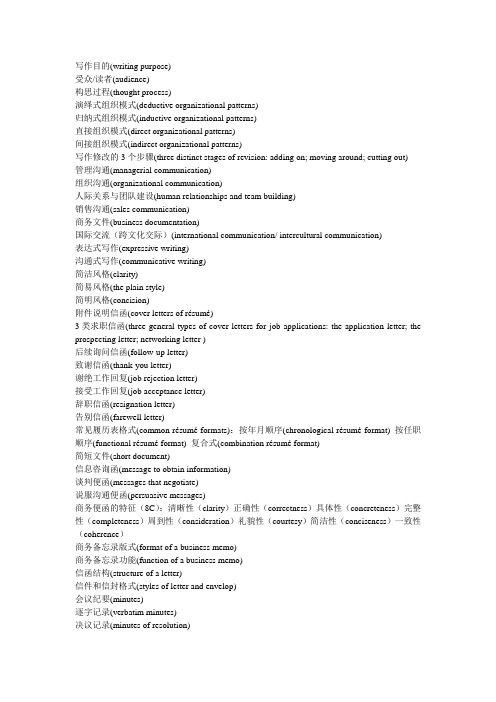
写作目的(writing purpose)受众/读者(audience)构思过程(thought process)演绎式组织模式(deductive organizational patterns)归纳式组织模式(inductive organizational patterns)直接组织模式(direct organizational patterns)间接组织模式(indirect organizational patterns)写作修改的3个步骤(three distinct stages of revision: adding on; moving around; cutting out)管理沟通(managerial communication)组织沟通(organizational communication)人际关系与团队建设(human relationships and team building)销售沟通(sales communication)商务文件(business documentation)国际交流(跨文化交际)(international communication/ intercultural communication)表达式写作(expressive writing)沟通式写作(communicative writing)简洁风格(clarity)简易风格(the plain style)简明风格(concision)附件说明信函(cover letters of résumé)3类求职信函(three general types of cover letters for job applications: the application letter; the prospecting letter; networking letter )后续询问信函(follow-up letter)致谢信函(thank-you letter)谢绝工作回复(job rejection letter)接受工作回复(job acceptance letter)辞职信函(resignation letter)告别信函(farewell letter)常见履历表格式(common résumé formats):按年月顺序(chronological résumé format) 按任职顺序(functional résumé format) 复合式(combination résumé format)简短文件(short document)信息咨询函(message to obtain information)谈判便函(messages that negotiate)说服沟通便函(persuasive messages)商务便函的特征(8C):清晰性(clarity)正确性(correctness)具体性(concreteness)完整性(completeness)周到性(consideration)礼貌性(courtesy)简洁性(conciseness)一致性(coherence)商务备忘录版式(format of a business memo)商务备忘录功能(function of a business memo)信函结构(structure of a letter)信件和信封格式(styles of letter and envelop)会议纪要(minutes)逐字记录(verbatim minutes)决议记录(minutes of resolution)陈述记录(minutes of narration)记录内容版式(minutes’ content format)会议议程(meeting agenda)会议筹划(meeting preparations)会议程序(3个环节)(meeting process: planning & preparing, conducting, and following-up) 会议后续工作(follow-up activities)后续文案职责(accountability of follow-ups)书面发言写作策略(writing strategies for business presentation)书面发言的材料组织(wring organization for business presentation)书面发言用语(language used in a presentation)书面发言避讳用语(language avoided in a presentation)人际沟通的功能(functions of interpersonal communication)人际沟通的目的(purpose of interpersonal communication)人际沟通的4个阶段(four general stages in interpersonal communication)团队的特征(group characteristics)团队的角色(group roles)团队影响力(group influence)沟通结构(communication structures)企业前景(vision)企业使命(mission)企业价值观(corporate values)企业目标(goal)战略计划(strategies)政策与流程(policies and procedures)业务流程的构成要素(15个)(content of procedures)业务流程的版式及内容(format of a procedure)商务文件的层次结构(3个)(tiers of documentation)ISO 9000质量体系(ISO 9000 Quality System )商务蓝皮书(blueprint)商务计划书(business plan)战略性计划书(strategic plan)战术性计划书(tactical plan)操作性计划书(operational plan)操作性管理(operational control)战术性管理(tactical control)战略性管理(strategic control)商务背景(business background)市场计划(marketing plan)财务预测(financial projections)行动计划(action plans)商务提案(business proposal)内部提案(internal proposal)外部提案(external proposal)招标提案(solicited proposal)非招标提案(unsolicited proposal)提案写作的简单模式(simple form for proposal writing)提案写作的复杂模式(detailed form for proposal writing)外部提案的结构要素(6个)(elements of the external proposal: introduction; problem identified and defined; objective & goal set; solutions proposed; implementation & measuring; costs and timeframe estimated)内部提案模式的内容版式(content format of internal proposal)征集提案(Request for Proposal, RFP)征集启示的基本要素(basic components of a RFP)提案评估(proposal evaluation)议程报告(agenda)行程安排(itinerary)费用支出报告(expense reports)项目进程报告(progress report)人事评估报告(personnel evaluation)第一手资料来源(primary sources)第二手资料来源(secondary sources)引证信息(documenting information)解析数据(interpreting data)常规商务报告(routine reports)任务报告(task reports)条目清单功能(itemized lists)图表辅助功能(graphic aids)标题的功能(headings)协议的本质(essence of a deal)合同的修订(contractual modifications)违约与补偿(breach of contract and remedy)律师费用条款(attorneys fees clause)合同免责(escape from contract)第三方签字(third party signature)合同追加条款(contract rider)合同授权(authorization)商务谈判(contract negotiation)合同起草(contract drafting)合同实施(execution)合同终止(closeout)合同(contract)合同有效性(validity of contracts)要约(offer) 接受(acceptance)法定权力(capacity)Sales contracts 买卖合同Contracts for supply of power ,water,gas or heat 供应电、水、气、热力合同Contracts for loan of money 借款合同Leasing contracts 租赁合同Financial leasing contracts 承揽合同Contracts for construction projects建设工程合同Carriage contracts运输合同Technology contracts 技术合同Safekeeping contracts 保管合同Warehousing contracts 仓库合同Agency appointment contracts 委托合同Trading-trust contracts行纪合同Brokerage contracts居间合同。
essay的名词解释
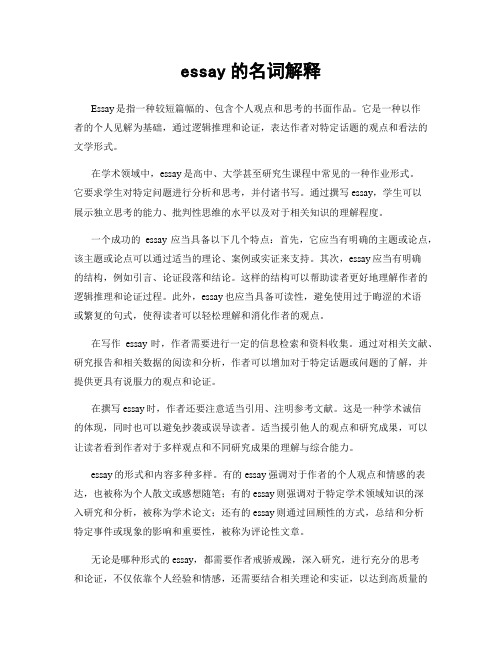
essay的名词解释Essay是指一种较短篇幅的、包含个人观点和思考的书面作品。
它是一种以作者的个人见解为基础,通过逻辑推理和论证,表达作者对特定话题的观点和看法的文学形式。
在学术领域中,essay是高中、大学甚至研究生课程中常见的一种作业形式。
它要求学生对特定问题进行分析和思考,并付诸书写。
通过撰写essay,学生可以展示独立思考的能力、批判性思维的水平以及对于相关知识的理解程度。
一个成功的essay应当具备以下几个特点:首先,它应当有明确的主题或论点,该主题或论点可以通过适当的理论、案例或实证来支持。
其次,essay应当有明确的结构,例如引言、论证段落和结论。
这样的结构可以帮助读者更好地理解作者的逻辑推理和论证过程。
此外,essay也应当具备可读性,避免使用过于晦涩的术语或繁复的句式,使得读者可以轻松理解和消化作者的观点。
在写作essay时,作者需要进行一定的信息检索和资料收集。
通过对相关文献、研究报告和相关数据的阅读和分析,作者可以增加对于特定话题或问题的了解,并提供更具有说服力的观点和论证。
在撰写essay时,作者还要注意适当引用、注明参考文献。
这是一种学术诚信的体现,同时也可以避免抄袭或误导读者。
适当援引他人的观点和研究成果,可以让读者看到作者对于多样观点和不同研究成果的理解与综合能力。
essay的形式和内容多种多样。
有的essay强调对于作者的个人观点和情感的表达,也被称为个人散文或感想随笔;有的essay则强调对于特定学术领域知识的深入研究和分析,被称为学术论文;还有的essay则通过回顾性的方式,总结和分析特定事件或现象的影响和重要性,被称为评论性文章。
无论是哪种形式的essay,都需要作者戒骄戒躁,深入研究,进行充分的思考和论证,不仅依靠个人经验和情感,还需要结合相关理论和实证,以达到高质量的写作水准。
同时,多次的修改和润色也是不可或缺的环节,通过反复打磨,使得整篇essay的逻辑性和可读性达到最佳状态。
英文写作术语大全(中英文对照)
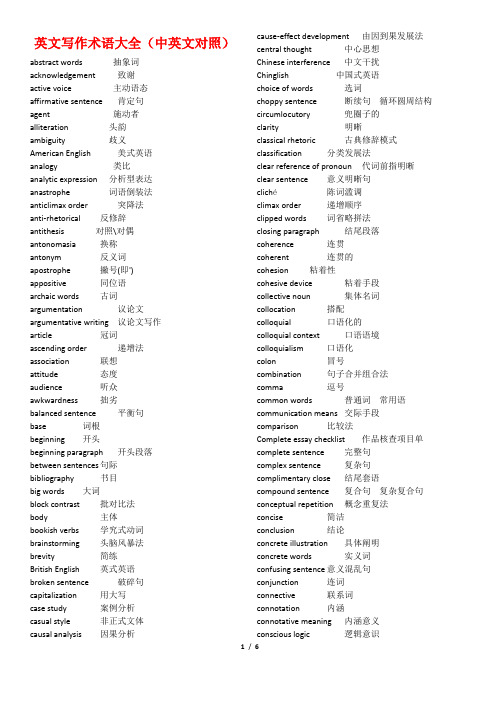
英文写作术语大全(中英文对照)abstract words 抽象词acknowledgement 致谢active voice 主动语态affirmative sentence 肯定句agent 施动者alliteration 头韵ambiguity 歧义American English 美式英语analogy 类比analytic expression 分析型表达anastrophe 词语倒装法anticlimax order 突降法anti-rhetorical 反修辞antithesis 对照\对偶antonomasia 换称antonym 反义词apostrophe 撇号(即')appositive 同位语archaic words 古词argumentation 议论文argumentative writing 议论文写作article 冠词ascending order 递增法association 联想attitude 态度audience 听众awkwardness 拙劣balanced sentence 平衡句base 词根beginning 开头beginning paragraph 开头段落between sentences 句际bibliography 书目big words 大词block contrast 批对比法body 主体bookish verbs 学究式动词brainstorming 头脑风暴法brevity 简练British English 英式英语broken sentence 破碎句capitalization 用大写case study 案例分析casual style 非正式文体causal analysis 因果分析cause-effect development 由因到果发展法central thought 中心思想Chinese interference 中文干扰Chinglish 中国式英语choice of words 选词choppy sentence 断续句循环圆周结构circumlocutory 兜圈子的clarity 明晰classical rhetoric 古典修辞模式classification 分类发展法clear reference of pronoun 代词前指明晰clear sentence 意义明晰句cliché陈词滥调climax order 递增顺序clipped words 词省略拼法closing paragraph 结尾段落coherence 连贯coherent 连贯的cohesion 粘着性cohesive device 粘着手段collective noun 集体名词collocation 搭配colloquial 口语化的colloquial context 口语语境colloquialism 口语化colon 冒号combination 句子合并组合法comma 逗号common words 普通词常用语communication means 交际手段comparison 比较法Complete essay checklist 作品核查项目单complete sentence 完整句complex sentence 复杂句complimentary close 结尾套语compound sentence 复合句复杂复合句conceptual repetition 概念重复法concise 简洁conclusion 结论concrete illustration 具体阐明concrete words 实义词confusing sentence 意义混乱句conjunction 连词connective 联系词connotation 内涵connotative meaning 内涵意义conscious logic 逻辑意识consistency 一致性consistent diction 选词一致性consonant 辅音consultative style 商谈体content 内容context 语境contraction 省略contrast 对比法controlling idea 主要思想,conversion 词性转换表达法co-occurrence 共现coordinating conjunction 复合句连词coordination 复合correlation 相关性corrupt English 迂腐英语cross-cultural writing 跨文化写作culture 文化curriculum vitae 简历dangling modifier 悬垂修饰语dash 破折号dateline 写信日期栏declarative sentence 陈述句deduction 演绎法deductive 演绎逻辑的deductive argumentation 演绎论证definite article 定冠词definition 定义法denotation 外延denotative meaning 外延意义descending order 递降顺序description 描写descriptive 描述性的descriptive writing 描写文development 发展diagram 图表说明diction 选词differentiation 区别digressive 跑题、离题的,印象法描写的直接法direct thinking pattern 直接了当的思维模式directions 题义指令discourse pattern 篇章模式distance from tone 语调产生距离,偏离计划主题division 分析分类法documenting the paper 论文引证domesticating strategy 归化战略domestication 归化法drably 表达干巴draft 草稿effect-cause development 由果到因发展法effective paragraph 表述有力的段落effective sentence 表达有力的句子effective variety 表达有力的变化egalitarian (思维)平等化elaboration 进一步详尽阐述electronic news media 电子新闻媒体embedding structure 内嵌结构emotional coloring 感情色彩emphasis 强调emphatic phrases 强调性短语emphatic structure 强调性结构emphatic words 强调性词语ending 结尾ending paragraph 结尾段落English thinking 英语思维English thinking characters 英语思维特征English thinking pattern 英语思维模式enumeration 列举法epigrammatic effect 隽语效果establish context 确立语境establish rapport 建立沟通基础euphemism 委婉语evaluating information 评估材料evidence 证据exclamation mark 感叹号exclamatory sentence 感叹句exemplification 举例法expected functions (信件的)期望交际功能expletive 虚词\填充词explicit language 明示的语言explicitness 明示性exposition 阐述文\议论文expository writing 议论文写作expounding 解释详细说明expressionism 表现主义fallacy in argumentation 论证谬误familiar 熟悉的faulty parallelism 错误平行feedback 反馈fiery language 情绪激动的语言figure of speech 修辞filler words 填充词first draft 第一稿first-person point of view 第一人称flashback 倒叙focus 中心foreignization 外化法foreignizing strategy 外化战略formal 正式的formal letter 正式信函formal repetition 形式重复法formal style 正式文体formal words 正式体词语formulating thesis statement 写作主题句four-character expression (汉语)四字成语fragmental sentence 破碎句free choice 自由选择frequency of usage 使用频率frozen expressions 极正式用语frozen style 极正式文体full spelling 完全拼法full stop 句号fullness (段落发展)充分性general connotation 普遍内涵意义general pattern 常见形式general words 一般词汇generalization 概括法general-specific pattern 由概括到具体发展模式genres 风格、体裁gobbledygook 官样文章、冗长费解的语言grammatical devices 语法技巧grammaticality 符合语法性heading 信头historical association 历史联想hyperbole 夸张法hyphen 分号hyphenated words 用连字号连接的词hyponymy 下义关系hyponym 下义词ideographic synonym 相对近义词idiom 成语idiomatic usage 习惯用法illustration 佐证imperative sentence 祈使句impersonal 非个性化的、客观的implicit language 含蓄语言implicitness 含蓄implied meaning 隐含意义impressionistic description 印象描写法indefinite article 不定冠词indent 行缩进in-depth analysis 深度分析individual words 独立个体词individualistic 个性化induction 归纳法inductive 归纳法的inductive argumentation 归纳法论证法inductive reasoning 归纳法论证infinitive mark 不定式标记inflexible and explicit logic 刚性显性逻辑informal 非正式的informal letter 非正式信函information focus 信息中心information missing 信息遗漏informative 提供信息的、提供知识的innuendo 讽刺、暗指inside address 信内地址interpretation of examples 对例子的诠释interpretative reporting 诠释性报告interrogative sentence 疑问句interrupting expressions 插入短语intimate 亲密intimate style 亲密体inverted pyramid form 倒金字塔形式inverted word order 词序颠倒法involved modifiers 复杂修饰语involved sentence 意义复杂句irony 反语jargon 行话journalese 新闻体journalistic writing 新闻写作justify the significance 论证意义keep to the point 紧扣主题key words 关键词lack of inflection 缺少词形变化language problem 语言问题learned words 学术用词lengthy passage 过长段落letter 信函levels of usage 用法层次lexical reference 句法前指法lexical stylistic devices 句法风格技巧line shifting 换行linear thinking pattern 线形思维模式listing 列举literal meaning 字面意义literary context 文学性语境literary works 文学作品literature review 文献回顾litotes 反语法、间接肯定法、曲言法locating information 搜索定位材料logical paragraphing 逻辑分段法logical thinking modes 逻辑思维模式,逻辑词逻辑短语logicalness 逻辑性long sentence 长句loose sentence 松散句loss of style 偏离一贯的风格main body 主体main idea 主要思想main point 要点manuscript 手稿、原稿margin 页边距materials collecting 材料搜集materials sorting 材料析选maxim of manner 方式次则maxim of quality 质量次则maxim of quantity 数量次则maxim of relevance 相关次则meaning 意义means 手段mechanical English 缺乏灵活的英语message 信息messy 混乱metaphor 隐喻metonymy 借代midget words 小词、常用词militant tone 态度强硬的语调misplaced modifier 错位修饰语modifier 修饰语monotony 单调mood 语态mood shifting 语态转换mouth-filler 口头禅narration 叙述体narrative 叙述体的narrative writing 叙述体写作nature of English language 英语语言本质neat 整洁negative meaning 负面意义negative sentence 否定句newly coined words 新撰词news report 新闻报道news report top-heavy 新闻报道的头重模式nominalization 名词化non-literature works 非文学作品nonrestrictive clause 非限制性从句nonrestrictive phrase 非限制性短语nonverbal language 非言语语言(手势、表情等)noun-oriented sentence 倾向名词化的句子novel 小说number 数number shifting 数的转换objective description 客观描写obscurity 意义不明on equal footing (写作风格)平等化one-sentence paragraph 一句段落onomatopoeia 拟声词opening paragraph 开头段落organization 组织outline 提纲oxymoron 矛盾修饰法padded expression 兜圈子的表达parady 仿拟paragraph 段落独立实体的段落paragraph development 段落发展法paragraphing 分段法parallel structure 平行结构parallelism 平行结构parentheses 插入语\圆括弧parenthetical expressions 插入语passive sentence 被动句period 句号periodic sentence 圆周句person 人称person shifting 人称转换personal 个体化的personal connotation 对个体而言的内涵意义personal letter 个人信函personification 拟人化persuasive writing 劝服性写作、以劝说为目的的写作phonetic stylistic device 语音风格技巧phrasal verbs 短语动词plain sentence 相对修辞句的平白句plantification 拟物point 意义点point of view 观点point-by-point contrast 逐点对比polite 礼貌体的poor English 英语表达力贫乏的positional relation 位置相关positivist-empirical 经验实证性power of communication 沟通力practical writing 应用文写作precise word 表达精确的词汇precision 精确prefix 前缀preparatory reading 写作预备阅读preposition 介词presenting ideas 阐述观点prewriting 写作前printed name of the sender 印刷体写信人姓名printed news media 印刷体新闻媒体problem-solution 提出问题-解决问题的模式process 程序法pronoun 代词pronoun shifting 代词转换proofread 校对proper names 专有名词public (语篇系统特征)公开性pun 双关语punctuation 标点punctuation mark 标点符号purposefulness 目的性Queen's English 标准英语question mark 问号quotation 引用quotation mark 引号quoted speech 引语reader 读者readers-oriented 读者为中心的reader-responsible 读者文责的reasoning 论证redundant collocation 多余搭配reference line 参考行register 语域句际关系relative noun 关系名词relative synonym 相对近义词repetition 重复repetition of structure 结构重复法report writing 报告写作research paper writing 研究报告写作restatement 重申法resume 个人简历return address 回信地址returning to the beginning 照应开头法revise 修改rhetoric 修辞rhetoric of sentence 句子修辞rhetorical analogy 修辞类比rhetorical question 反问句rhetorical words 华丽用语round character 性格充分体现的人物roundabout style 迂回风格run-on sentence “连环”句salutation 称呼语sample 样本sarcasm 讽刺semicolon 分号sentencing 组句setting 场景shades of meaning 隐含义short preposition 短介词short sentence 短句short story 短篇故事signature 签名simile 明喻simple English 简明英语simple sentence 简单句simple words 简单词sincerity 真诚性singleness of purpose 目的唯一性situation 情景situationally appropriate 于情景贴切的slang 俚语social association 社会联想special terms 特殊术语specific words 具体词汇speech 口头言语spelling 拼写stage 步骤法statistics 数据法strength of meaning 意义力度strength of word 词语力度stringy sentence “连环”句structural behavior 结构行为style 风格、文体style is the man 风格即人style makes sense 风格即成意义stylistic coloring 文体色彩stylistic label 文体标记stylistic reference 文体照应stylistic synonym 风格近义词stylistically appropriate 于文体贴切的sub-ideas 次思想subject 主题subject line 主题行subject-oriented 以主题为中心的subject-verb agreement 主谓一致subordination 句子从属组合法subsidiary points 副观点substantial verb 实义动词substitution 替代法sub-topics 副主题suffix 后缀summary 摘要superordinate 上义词,高级词suspense 悬念syllable 音节syllogism 三段论、演绎推理symbolic 符号的synaesthesia 通感,同感synecdoche 提喻synonym 近义词syntactical stylistic device 句法风格技巧synthetic expression 综合型表达systematic 系统性tense shifting 时的转换terse passage 简练的行文test writing 应试写作textual distribution 文稿布局the right style 合适的风格theme 主题third-person point of view 第三人称timed writing 限时作文title writing 标题写作to preach 训导式、说教式to reason 讲道理、逻辑论证tone 语调tones of voice 语气topic 话题topic sentence 主题句transferred epithet/ hypallage 移就transition 过渡transitional mark 过渡标记transitional techniques 过渡技巧truthfulness 真实性types of characters 人物性格类别ungrammaticality 不符合语法性unity 统一性unnatural shifting 不自然转换usage 用法variation 趋势分析variety 多样化verbal language 言语语言verbalization 动词化verb-oriented sentence 倾向动词化的句子vigor 力度vividness 生动vocabulary 词汇vogue slang 流行俚语vowel 元音vulgar words 平民词语word class 词类word division 断词法word order 词序word power 单词表达力wordiness 多话、罗嗦wordy 罗嗦的writer-responsible 作者文责的writer's purpose 作者目的writing 写作writing attitudes 写作态度writing process 写作过程writing purpose 写作目的zero affix 零缀\词性转换法zero derivation 零缀\词性转换法。
英美文学名词解释总结
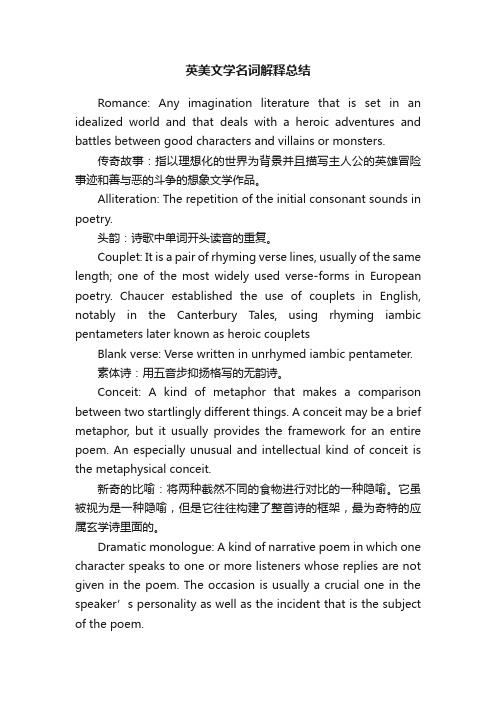
英美文学名词解释总结Romance: Any imagination literature that is set in an idealized world and that deals with a heroic adventures and battles between good characters and villains or monsters.传奇故事:指以理想化的世界为背景并且描写主人公的英雄冒险事迹和善与恶的斗争的想象文学作品。
Alliteration: The repetition of the initial consonant sounds in poetry.头韵:诗歌中单词开头读音的重复。
Couplet: It is a pair of rhyming verse lines, usually of the same length; one of the most widely used verse-forms in European poetry. Chaucer established the use of couplets in English, notably in the Canterbury Tales, using rhyming iambic pentameters later known as heroic coupletsBlank verse: Verse written in unrhymed iambic pentameter.素体诗:用五音步抑扬格写的无韵诗。
Conceit: A kind of metaphor that makes a comparison between two startlingly different things. A conceit may be a brief metaphor, but it usually provides the framework for an entire poem. An especially unusual and intellectual kind of conceit is the metaphysical conceit.新奇的比喻:将两种截然不同的食物进行对比的一种隐喻。
英美文学名词解释TermsinEnglishLiterature

英美文学名词解释Terms in English Literature1.Allegory (寓言)A tale in verse or prose in which characters, actions, or settings represent abstract ideas or moral qualities.寓言,讽喻:一种文学、戏剧或绘画的艺术手法,其中人物和事件代表抽象的观点、原则或支配力。
2.Alliteration (头韵)Alliteration is the repetition of the same initial consonant sound within a line or a group of words. 头韵:在一组词的开头或重读音节中对相同辅音或不同元音的重复。
3.Allusion (典故)A reference to a person, a place, an event, or a literary work that a writer expects the reader to recognize and respond to.典故:作者对某些读者熟悉并能够作出反映的特定人物,地点,事件,文学作品的引用。
4.Analogy (类比)A comparison made between two things to show the similarities between them.类比:为了在两个事物之间找出差别而进行的比较。
5. Antagonist (反面主角)The principal character in opposition to the protagonist or hero or heroine of a narrative or drama.反面主角:叙事文学或戏剧中与男女主人公或英雄相对立的主要人物。
6. Antithesis (对仗)The balancing of two contrasting ideas, words, or sentences.对仗:两组相对的思想,言辞,词句的平衡。
写作的英文名词解释

写作的英文名词解释写作是一种表达思想和感情的艺术形式,被广泛应用于各个领域。
无论是学术著述、文学作品,还是商业文件或者个人博客,写作都是人们传递信息和沟通思想的关键工具。
在本文中,我们将解释与写作相关的几个重要英文名词。
1. Composition(作文)Composition是指通过书面形式表达思想和观点的过程。
作文不仅要求有良好的语法和词汇运用,还需要有清晰的逻辑结构和准确的表达。
学生们在学校会经常被要求写作文,以提高他们的语言表达能力和思考能力。
2. Narrative(叙事)Narrative是一种讲述故事的写作方式。
通过故事的叙述,作者可以吸引读者的兴趣,并传递出特定的情感和主题。
叙事写作通常包括引入、发展和结尾三个阶段,以营造情节的张力和逻辑的完整性。
3. Description(描述)Description是一种通过详细描写来传达感觉、形象和事物特征的写作形式。
通过运用形容词、副词和具体细节,作者可以生动地描绘出人物、地点或物体的外貌和特点。
描述写作在文学作品、旅行散文和科学报道中都得到广泛运用。
4. Persuasion(说服)Persuasion是一种通过论证和论据来影响读者观点和行为的写作形式。
说服性写作要求作者能够提供充分的证据和合理的逻辑,以支持自己的观点,并使读者相信和接受它。
这种写作形式常见于辩论演讲、广告和政治演说。
5. Editing(编辑)Editing是指对已完成的写作进行修改和润色的过程。
编辑旨在提高写作的质量和准确性,包括检查语法错误、改进句子结构、优化词汇选择和确保逻辑一致性。
通过编辑,作者可以让自己的写作更加清晰、流畅,并确保传递的信息准确无误。
6. Rewriting(重写)Rewriting是指对已完成的写作进行全面的重构和调整。
与编辑不同,重写更着重于对内容和结构的修改,以改进整体的逻辑、连贯性和读者体验。
通过重写,作者可以对自己的思想进行更深入的思考,使作品更加精炼和有力。
英语的各名词解释

英语的各名词解释英语作为一门主要的通用语言,被全球范围内广泛使用。
在我们日常使用英语的过程中,我们经常会遇到各种各样的名词。
本文将对一些常见的英语名词进行解释,帮助读者更好地理解这些概念。
以下是一些我们经常遇到的名词及其解释:1. Vocabulary(词汇)词汇是语言的基础,是构建语言表达的基本单元。
它包含了各种单词和短语,用于表达思想、情感和概念。
词汇的掌握对于学习一门语言至关重要,它能帮助我们更好地理解和沟通。
2. Grammar(语法)语法是一门语言的基本组织规则。
它包括了词汇的用法、句子的结构以及各种语法规则。
学习语法可以帮助我们正确地构建句子,使我们的表达更加准确和流畅。
3. Pronunciation(发音)发音是指我们在口语中使用语音和音标来表达单词和句子。
正确的发音对于与他人的有效交流至关重要。
学习发音可以帮助我们准确地表达自己的意思,并更好地理解他人的表达。
4. Listening(听力)听力是指通过倾听他人的口语来理解其意思的能力。
良好的听力技巧是学习一门语言的核心能力之一。
通过提高听力技巧,我们能更好地理解他人的表达,并从中学习新的词汇和句式。
5. Speaking(口语)口语是指用语音和语调表达自己的思想和情感的能力。
良好的口语技巧可以帮助我们更好地与他人交流,并且在实际情境中更准确地表达自己的意思。
6. Reading(阅读)阅读是指通过阅读文字来获取信息和理解意思的能力。
通过阅读,我们可以接触到丰富的文化知识、学习新的词汇和语法结构,并提高我们的语言理解能力。
7. Writing(写作)写作是通过书写文字来表达思想和观点的能力。
良好的写作技巧可以帮助我们更准确地表达自己的意思,并以清晰的方式传达给读者。
8. Fluency(流利度)流利度是指在使用一门语言时,轻松自如地表达自己的能力。
它包括了发音流利、词汇量丰富、语法准确以及思维和语言的自然衔接等方面。
提高流利度需要通过不断的练习和实践来达到。
英语学名词解释和简答题的定义和特点是什么?
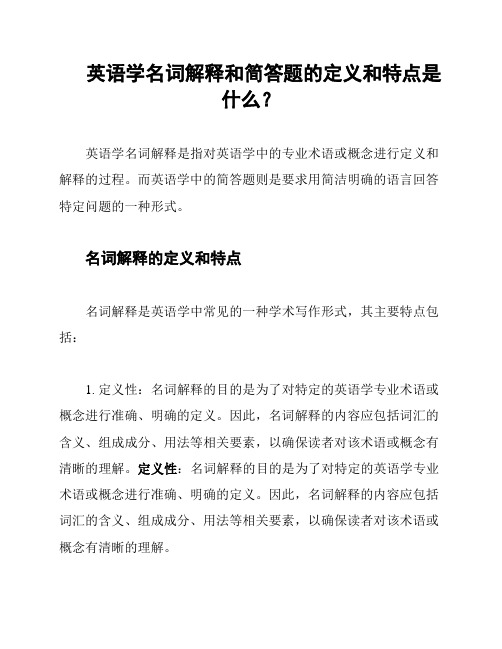
英语学名词解释和简答题的定义和特点是什么?英语学名词解释是指对英语学中的专业术语或概念进行定义和解释的过程。
而英语学中的简答题则是要求用简洁明确的语言回答特定问题的一种形式。
名词解释的定义和特点名词解释是英语学中常见的一种学术写作形式,其主要特点包括:1. 定义性:名词解释的目的是为了对特定的英语学专业术语或概念进行准确、明确的定义。
因此,名词解释的内容应包括词汇的含义、组成成分、用法等相关要素,以确保读者对该术语或概念有清晰的理解。
定义性:名词解释的目的是为了对特定的英语学专业术语或概念进行准确、明确的定义。
因此,名词解释的内容应包括词汇的含义、组成成分、用法等相关要素,以确保读者对该术语或概念有清晰的理解。
2. 简明扼要:名词解释需要用简明扼要的语言进行表达,避免冗长或复杂的描述,以便读者能迅速理解和掌握所解释的英语学术语或概念。
简明扼要:名词解释需要用简明扼要的语言进行表达,避免冗长或复杂的描述,以便读者能迅速理解和掌握所解释的英语学术语或概念。
3. 客观中立:名词解释应以客观中立的方式呈现,避免主观性的评价或偏见。
解释应基于权威的资料和研究,提供客观可靠的信息。
客观中立:名词解释应以客观中立的方式呈现,避免主观性的评价或偏见。
解释应基于权威的资料和研究,提供客观可靠的信息。
4. 内容关联:名词解释应与所涉及的英语学领域紧密相关,确保解释内容与该领域的研究和理论体系相一致。
内容关联:名词解释应与所涉及的英语学领域紧密相关,确保解释内容与该领域的研究和理论体系相一致。
简答题的定义和特点简答题是英语学中常见的一种问答形式,其主要特点包括:1. 简洁明确:简答题要求在简短的篇幅内回答问题,应以简洁明确的语言表达观点和答案。
简洁明确:简答题要求在简短的篇幅内回答问题,应以简洁明确的语言表达观点和答案。
2. 针对性强:简答题会明确提出特定问题,要求回答者对该问题进行分析和回答,回答应围绕问题的核心进行,避免赘述和离题。
英语写作议论文的名词解释
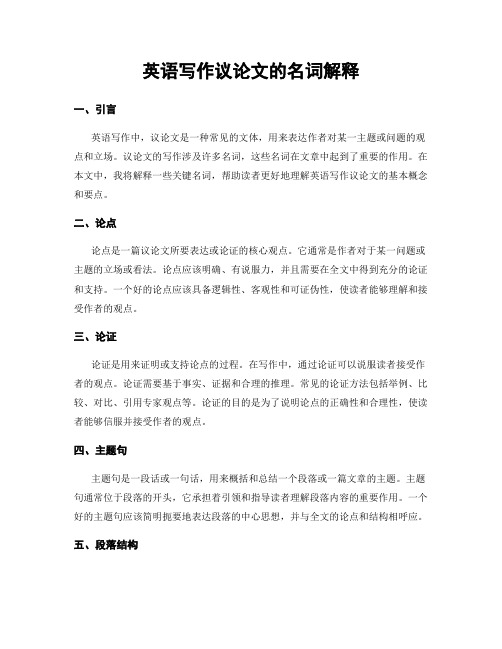
英语写作议论文的名词解释一、引言英语写作中,议论文是一种常见的文体,用来表达作者对某一主题或问题的观点和立场。
议论文的写作涉及许多名词,这些名词在文章中起到了重要的作用。
在本文中,我将解释一些关键名词,帮助读者更好地理解英语写作议论文的基本概念和要点。
二、论点论点是一篇议论文所要表达或论证的核心观点。
它通常是作者对于某一问题或主题的立场或看法。
论点应该明确、有说服力,并且需要在全文中得到充分的论证和支持。
一个好的论点应该具备逻辑性、客观性和可证伪性,使读者能够理解和接受作者的观点。
三、论证论证是用来证明或支持论点的过程。
在写作中,通过论证可以说服读者接受作者的观点。
论证需要基于事实、证据和合理的推理。
常见的论证方法包括举例、比较、对比、引用专家观点等。
论证的目的是为了说明论点的正确性和合理性,使读者能够信服并接受作者的观点。
四、主题句主题句是一段话或一句话,用来概括和总结一个段落或一篇文章的主题。
主题句通常位于段落的开头,它承担着引领和指导读者理解段落内容的重要作用。
一个好的主题句应该简明扼要地表达段落的中心思想,并与全文的论点和结构相呼应。
五、段落结构段落结构在议论文的写作中非常重要。
一个良好的段落结构应该具有逻辑性和连贯性,使读者能够清楚地理解作者的意思。
一个典型的段落结构应包括主题句、论据和结论。
主题句在段落开头引出主题,论据用来支持和证明主题句,结论总结并扩展主题句的观点。
合理的段落结构能够使文章的思路更加清晰,逻辑更加紧密。
六、论文结构论文结构是指整篇议论文的组织结构和逻辑顺序。
一个好的论文结构应该能够使读者能够快速理解全文的内容和观点。
通常,一篇议论文包括引言、正文和结论三个部分。
引言部分用来引入话题和背景,引起读者的兴趣;正文部分是对论点进行论证和论述的部分,包括论点、论证、举例等;结论部分是对全文观点的总结和扩展。
良好的论文结构能够使文章有条不紊地展开,逻辑清晰,读者容易理解和接受作者的观点。
essay 的名词解释

essay 的名词解释Essay的名词解释Essay,源自法语essayer(尝试、试验),最早用于指代一种随笔式的文学作品,是一种非虚构性的散文体裁。
Essay通常是作者对某个主题或问题的观点和思考的书面表达,具有一定的深度和个人见解。
它不同于严肃的学术论文,也不同于小说或诗歌,更偏向于一种对于现象、事件或思想的独立解读和评论。
Essay以其灵活自由的形式,提供了一个作者表达观点和独特思考的空间。
通常,essay会通过对主题的全面研究和思考,以及充分支持论点的文章结构和逻辑,使读者认同作者的观点或意见。
因此,essay的核心在于通过引人入胜的叙述,巧妙地讲述复杂问题,并展示个人的思考过程和见解。
在essay的写作过程中,作者往往需要广泛的阅读和研究,以确保对主题有足够的了解和知识储备。
这也使得essay常常具有较强的知识性和信息价值。
通过引用和参考其他学者、专家的观点和研究成果,作者能够进一步支持自己的论点,并增强文章的说服力和可信度。
Essay通常以自由发挥和独特性见长,作者可以结合个人经历、观察和思考,通过个人的感受和体验,揭示问题的独特解读。
这一点,使得essay在文学创作和个人叙事中扮演着重要的角色。
同时,essay也成为各类学术论文和考试答题的重要形式,考察学生的分析和表达能力。
在写作过程中,essay的结构也起着重要的作用。
虽然没有统一的格式或模板,但通常会包括引言、论证段落和结论。
引言部分为文章引出主题,概述观点,并引起读者关注。
论证段落则致力于通过实例、论据、数据、研究结果等方法,论证和支持作者的观点。
结论则总结了整个essay的核心观点,并给读者一个有力的印象。
Essay的写作,旨在通过深入的思考和语言驾驭的结合,为读者呈现一个独特的观点和见解。
它可以通过作者的个人感受和情感投入,引起读者的共鸣,并为读者带来新的思考方式和视角。
通过独立思考和客观评述,essay不仅为传递信息和知识提供了一种有趣的方式,也促进了思维的发展和文化的传承。
- 1、下载文档前请自行甄别文档内容的完整性,平台不提供额外的编辑、内容补充、找答案等附加服务。
- 2、"仅部分预览"的文档,不可在线预览部分如存在完整性等问题,可反馈申请退款(可完整预览的文档不适用该条件!)。
- 3、如文档侵犯您的权益,请联系客服反馈,我们会尽快为您处理(人工客服工作时间:9:00-18:30)。
What is a summary?A summary is a short piece of writing that gives the main facts or ideas of a story or article,etc. The qualities of a good summary?It should be objective,that is,the writer does not include any ideas of his/her own. It should be complete ,that is,the writer does not leave out important facts or ideas.It should be balanced,in other words,the writer gives equal attention to each main idea.The goal of a summary?It is to give readers an objective,complete,accurate and balanced view ofsomething(an article,a story ,a novel,a play,etc)Paragraph unityA unified paragraph contains only sentences that explain or support the general statement made in the topic sentence.Any sentence that does not relate to (=is not connected in some way)the main idea will not develop it.How to achieve paragraph unity?Begin with a discussable point and express it in a topic sentence.Stick to this single point throughout,that is,all other sentence should be aboutthis point.Prove or develop the point;don 't merely repeat it.Link your sentence to make your ideas easy to follow.How to outline (=to give the main facts about something) a story?Divide the story into smaller parts. Summarize each part in one sentence.Number your sentence summaries to make them an outline of the story.What is a narrative paragraph?A narrative paragraph is one that briefly describes an incident or a personal experience. Requirements that a good narrative paragraph should meet?Though its length is limited,it is complete,that is,it has a beginning,middle and end.It includes as little conversation as possible.Its sentences are connected by suitable linking words or expressions.Here are some common time linking words/expressions.Afterward later when shortly afterward soon while the next day/night then Paragraph coherence(Coherence is connection )A coherent paragraph is one in which every sentence after the first is connected to the one before it,to the topic sentence ,or to both ,and readers can readily follow the writer 's train of thought(= a related series of thoughts)An incoherence paragraph is one in which the sentences are badly connected or not connected at all,and the readers are likely to lose their way.How to achieve paragraph coherence?Arrange sentence in a clear order.Use correct pronounsUse correct linking words and expressions.What is exposition?Exposition is explanatory writing.Its purpose is to explain or clarify a point. Patterns of expositionExemplificationProcess analysis Cause-Effect analysis Comparison and contrast Classification Definition Analogy What is exemplification?Exemplification is a method of supporting a thesis statement with a series of specific examples or sometimes,with a single extended example.It is one of the most common and most useful means of developing a paragraph or an essay.What is an essay?An essay is a related group of paragraphs written for some purpose.Types of essaysEssays can be classified into types,or modes,according to their purposes. Narrative essays relate a sequence of events,whether factual or not.Descriptive essays create a word picture of a scene,a person,or an object.Expositive essays explain--to inform,instruct,clarify,illustrate,or define. Argumentative essays state an opinion and defend it logically.Basic structure of an expositive essayAn expositive essay has three parts: A beginning called the introduction. A middle called the body.An end called the conclusion.Elements of the expositive essay OutliningThesis statementTitleTransitionWhat is an outline?An outline is a method of organizing materials in logical order.It is a list that shows the main ideas and the structure of something you are planning to write.In other words,it is a plan for a piece of writing.Constructing an outline makes the writing of your essay easier.Types of outline1.Topic outline,which uses only key words and phrases.2.Sentence outline,which uses complete sentence.Format(the arrangement ,design,or organization of something)A topic outline looks like this:Thesis:In my first year at college,I learned to spend my money wisely.What is process analysis?A process analysis is a step-by-step explanation of how to do something,or how something works/done or made,or something happened.What is process analysis used for?1.To give directions to people who want or need to perform the process.(giving instructions )2.To give information to those who want to understand the process but may not actually performit.(giving information)3.To explain how something happened.(giving the history) What are the major typesof process analysis?1.Directive process analysis which is aimed at explaining how to do or make something.rmative process analysis which is aimed at explaining how something is done/works or how something took place/happened.What is comparison/contrast?Comparison/contrast is a method of developing a paragraph or an parison shows similarity while contrast shows difference.The word comparison is sometimes used to mean both comparison and contrast.What is comparison/contrast used for?1.To clarify something unknown or not well understood.2.To lead a new way of viewing something familiar.3.To bring one or both of the subjects into sharper focus.4.To show that one subject is better than the other. What is classification? Classification is the method of grouping objects,people,or ideas systematically.Itis one of the most useful organizational strategies in writing.What is classification used for?1.To organize and perceive the world around us.2.To present a mass of material by means of some orderly system.3.To deal with complex or abstract topics by breaking a broad subject intosmaller,neatly sorted categories.What is definition?1.Definition is the explanation of the meaning of a word or concept.2.Definition is also a method of developing an essay.What is analogy?Analogy is an extended comparison based on the similar features of two things of different classes,one familiar one easily understood,the otherunfamiliar ,abstract,or complicated.It is an important method of exposition.What are transition?Transition,also called ”transitional devices ”,are words,phrases,and even whole sentences that link sentence to one another.What is a journal?A journal is a record of experiences,ideas,or reflections kept regularly for private use.It is something “for you eye only ”.So you can write from your heart and letideas and feelings flow freely.Journal writing is a form of free-writing,which involves writing whatever comes to your mind about what happens around you and what you observe and think about. Argumentation and persuasion defined.Argumentation-persuasion is the type of writing in which writers try to encourage readers to accept their point of view on a controversial issue.In argumentation ,writers use objectives,logical reasoning,facts,and hard evidence to demonstrate the soundness of a position.Their purpose is to encourage readers to accept their point of view.In persuasion,writers use emotional language and dramatic appeals to readers' concerns,beliefs and values,often in the hope of encouraging then to take a specific action,besides,encouraging acceptance of an opinion.Argumentation and persuasion are frequently used together in an essay.Also,the two terms are often used interchangeably.The claim definedClaims,or propositions,represent answers to what you are trying to prove in an argumentative essay.Although they are the conclusions of your arguments,they often appear as these statements. Abstract&concrete wordsConcrete words identify persons and things that can be perceived by the senses--seen,heard,tasted,felt,smelled,e.g.table,boy,rose,etc.Abstract words denote qualities,concepts,relationships,acts,conditions,ideas that we can 't perceive directly through our five senses,e.g.honesty,friendship,life,etc. Most words are neither wholly abstract nor concrete.They are between the two extremes,e.g.exercise,rest,answer,etc.General&specific wordsSpecific words identify individual items in a group,e.g.BuickGeneral words relate to categories,an overall group,e.g.carMost words are neither wholly general nor specific.They are between the two extremes,e.g.child,student,flower,etc.The support definedThe ideas and information intended to convince readers that the claim is sound or believable. What is conciseness?Conciseness means being direct and to the point.Redundant words or wordy writing is not concise.Do not over-use words to deliver the message in your writing.Refutation definedRefutation is attempts to prove views against the writer 's position wrong or false.It is often an indispensable part of an argumentative essay,for it shows that the writer is aware of opposing viewpoints and has thought about both sides.Essays that mainly refute opposing views are known as rebuttal arguments.Fallacies definedFallacies are statements that may sound reasonable or true but are not logically defensible and may actually be deceptive.The emotional appeal definedEmotional appeal is a strategy writers and public speakers use to persuade,which is to arouse the reader's/audience's feelings to reinforce an argument.真题:What is the research paper?What is the process of writing it?A research paper is usually a formal,fairly long and well-documented composition. Process: 1.choosing a topic2.Collecting information3.Analyzing the information,organizing ideas and working out an outline4.Writing the first draft5.Revising the draft and finalizing the paper.What is the sentence?What is the effective sentence?A sentence contains at least a subject and a predicate verb:if the verb is transitive,there must be an object,if the verb is a link verb,there must be a predicative or complement.They are unity,coherence,conciseness,emphasis and variety.How many types of sentences according to the use?What are they?There are four.They are declarative,interrogative,imperative and exclamatory sentence.How many types of sentences according to the structure?What are they?There are four.They are simple,compound,complex and compound-complex sentence.。
